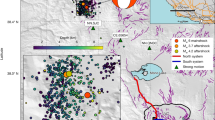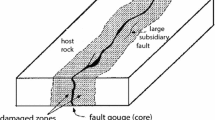Abstract
The disastrous Sumatra–Andaman earthquake of 26 December 2004 was one of the largest ever recorded. The damage potential of such earthquakes depends on the extent and magnitude of fault slip. The first reliable moment magnitude estimate1 of 9.0 was obtained several hours after the Sumatra–Andaman earthquake, but more recent, longer-period, normal-mode analyses have indicated that it had a moment magnitude of 9.3, about 2.5 times larger2. Here we introduce a method for directly imaging earthquake rupture that uses the first-arriving compressional wave and is potentially able to produce detailed images within 30 min of rupture initiation. We used the Hi-Net seismic array in Japan as an antenna to map the progression of slip by monitoring the direction of high-frequency radiation. We find that the rupture spread over the entire 1,300-km-long aftershock zone by propagating northward at roughly 2.8 km s-1 for approximately 8 minutes. Comparisons with the aftershock areas of other great earthquakes indicate that the Sumatra–Andaman earthquake did indeed have a moment magnitude of ∼9.3. Its rupture, in both duration and extent, is the longest ever recorded.





Similar content being viewed by others
References
Dziewonski, A. M. & Woodhouse, J. H. An experiment in systematic study of global seismicity: Centroid-moment tensor solutions for 201 moderate and large earthquakes of 1981. J. Geophys. Res. 88, 3247–3271 (1983)
Stein, S. & Okal, E. A. Speed and size of the Sumatra earthquake. Nature 434, 581–582 (2005)
Ni, S., Kanamori, H. & Helmberger, D. Energy radiation from the Sumatra earthquake. Nature 434, 582 (2005)
National Research Institute for Earth Science and Disaster Prevention. http://www.hinet.bosai.go.jp (2005).
Ellsworth, W. L. Imaging fault rupture without inversion. Seismol. Res. Lett. 63, 73 (1992)
Spudich, P. & Cranswick, E. Direct observation of rupture propagation during the Imperial Valley earthquake using a short baseline accelerometer array. Bull. Seismol. Soc. Am. 74, 2083–2114 (1984)
Ortiz, M. & Bilham, R. Source area and rupture parameters of the 31 December 1881 Mw = 7.9 Car Nicobar earthquake estimated from tsunamis recorded in the Bay of Bengal. J. Geophys. Res. 108 (2003) doi:10.1029/2002JB001941
Houston, H. & Kanamori, H. Source spectra of great earthquakes: Teleseismic constraints on rupture process and strong ground motion. Bull. Seismol. Soc. Am. 76, 19–42 (1986)
Kanamori, H. & Cipar, J. J. Focal process of the great Chilean earthquake May 22, 1960. Phys. Earth Planet. Inter. 9, 128–136 (1974)
Christensen, D. H. & Beck, S. L. The rupture process and tectonic implications of the great 1964 Prince-William-Sound earthquake. Pure Appl. Geophys. 142, 29–53 (1994)
Johnson, J. M. et al. The 1957 great Aleutian earthquake. Pure Appl. Geophys. 142, 3–28 (1994)
Beck, S. L. & Christensen, D. H. Rupture process of the February 4, 1965, Rat Islands earthquake. J. Geophys. Res. 96, 2205–2221 (1991)
McGuire, J. J., Zhao, L. & Jordan, T. H. Predominance of unilateral rupture for a global catalog of large earthquakes. Bull. Seismol. Soc. Am. 92, 3309–3317 (2002)
Kanamori, H. & Brodsky, E. E. The physics of earthquakes. Rep. Prog. Phys. 67, 1429–1496 (2004)
Kanamori, H. The energy release in great earthquakes. J. Geophys. Res. 82, 2981–2987 (1977)
Shearer, P. M. & Earle, P. S. The global short-period wavefield modelled with a Monte Carlo seismic phonon method. Geophys. J. Int. 158, 1103–1117 (2004)
Kennett, B. L. N. IASPEI 1991 Seismological Tables (Research School of Earth Sciences, Australia National University, Canberra, Australia, 1991)
Brazee, R. J. & Cloud, W. K. United States Earthquakes 1957 (US Coast and Geodetic Survey, Washington DC, 1959)
Algermissen, S. T., Rinehart, W. A., Sherburne, R. W. & Dillinger, W. H. The Great Alaska Earthquake of 1964 313–364 (National Academy of Sciences, Washington DC, 1972)
Talley, J. H. C. & Cloud, W. K. United States Earthquakes 1960 (US Coast and Geodetic Survey, Washington DC, 1962)
Acknowledgements
We thank the National Research Institute for Earth Science and Disaster Prevention in Japan for making the Hi-Net data available on the Internet.
Author information
Authors and Affiliations
Corresponding author
Ethics declarations
Competing interests
Reprints and permissions information is available at npg.nature.com/reprintsandpermissions. The authors declare no competing financial interests.
Supplementary information
Supplementary Figure S1
Cumulative radiated energy (as in main text Figure 4), but using synthetic seismograms with point sources at six locations indicated by black stars and spaced at 100 s interval. (DOC 140 kb)
Rights and permissions
About this article
Cite this article
Ishii, M., Shearer, P., Houston, H. et al. Extent, duration and speed of the 2004 Sumatra–Andaman earthquake imaged by the Hi-Net array. Nature 435, 933–936 (2005). https://doi.org/10.1038/nature03675
Received:
Accepted:
Issue Date:
DOI: https://doi.org/10.1038/nature03675
- Springer Nature Limited
This article is cited by
-
The first 30 min hidden aftershocks of the 2022 September 17, ML 6.4, Guanshan, Taiwan earthquake and its seismological implications
Terrestrial, Atmospheric and Oceanic Sciences (2024)
-
The break of earthquake asperities imaged by distributed acoustic sensing
Nature (2023)
-
The overall-subshear and multi-segment rupture of the 2023 Mw7.8 Kahramanmaraş, Turkey earthquake in millennia supercycle
Communications Earth & Environment (2023)
-
Sources of seismic activity imaged using telecom fibre cables
Nature (2023)
-
Early Report of the Source Characteristics, Ground Motions, and Casualty Estimates of the 2023 Mw 7.8 and 7.5 Turkey Earthquakes
Journal of Earth Science (2023)





